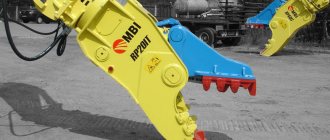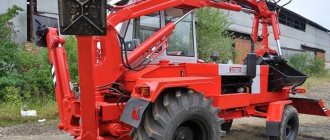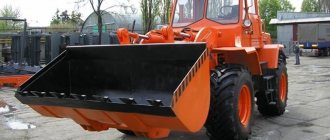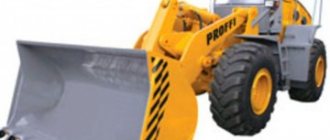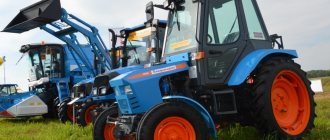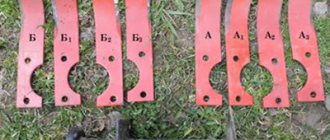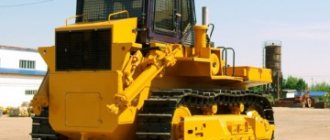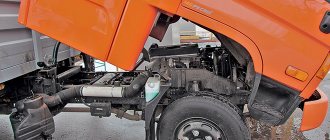Backhoe loaders equipped with a grab are always useful where speed, good reach and considerable effort are needed. Excavation work, unloading and loading (especially bulk substances), small planning - they can do all this quite well. One of the modern models of such units is Karpatets PEA 1A, which successfully operates in many parts of the world.
About the manufacturer of this loader model
Kolomyia Agricultural Machinery Plant (aka “Kolomiya Agricultural Machinery Plant”) is located in the city of Kolomyia, Ivano-Frankivsk region of Ukraine.
This enterprise dates back to 1869, when a mechanical workshop was founded in Kolomyia, producing a wide variety of agricultural implements, carts, hand straw cutters, cast-iron cookers and other metal products.
At that time, Ukraine was not yet united - the city of Kolomyia was part of Austria-Hungary. During the First World War, mechanical workshops (which had already expanded significantly by that time) were reoriented to the production of barbed wire and other military products.
After the collapse of the Austro-Hungarian and Russian empires, from May 1919 to September 1939, the city of Kolomyia was part of Poland.
In 1939, after the unification of Ukraine within the USSR, the enterprise was nationalized and, in accordance with the fourth five-year plan for the development of the national economy of the USSR, was modernized. The plant began producing agricultural products again. In 1941-1944. it was owned by the German occupiers.
In 1948, a large multi-year order was placed at the Kolomyia Agricultural Machinery Plant for the production of feed grinders for collective farm livestock farms throughout the Soviet Union.
In 1957, the plant first mastered the production of loading and unloading agricultural machines with a hydraulic drive, and in 1958 their production was put on stream: 218 PG-0.5 grab loaders were produced in Kolomyia.
In 1963, the design bureau of grab loaders at the Kolomyia plant developed a special unit for Fidel Castro’s overseas friend - a grab loader that automates the process of loading and unloading sugar cane: PG-0.5ST with a lifting capacity of 0.5 tons.
The plant supplied machines of this model to Cuba until 1988, producing more than 15 thousand PG-0.5ST loaders. They had a huge impact on the development of the sugar industry in the country of Liberty Island.
The main model for the domestic market of the USSR and other “fraternal countries” was the universal loader-excavator PE-0.8, which in 1966 was presented at the international exhibition “Modern Agricultural Machinery and Equipment” in Moscow, and immediately went into mass production.
In one of the assembly shops of Kolomyyaselmash
In 1969, for its significant contribution to the development of the national economy of the country, the Kolomyia Agricultural Machinery Plant was awarded the Order of the Badge of Honor.
In 1982, the enterprise was significantly modernized, with the commissioning of additional production facilities, and in 1983, serial production of modern (at that time) autonomous loaders PEA-1.0 and PEA-1A was launched in Kolomyia.
In Soviet times, the plant was a city-forming enterprise, was provided with orders for many years to come and was the largest manufacturer of grab loaders in the USSR.
After the collapse of the Union, the enterprise was transformed from a state-owned company into a joint-stock company. However, it was included in the list of enterprises of strategic importance for the economy and security of Ukraine (in August 1997).
In 2003, the Kolomyia Agricultural Machinery Plant went bankrupt. Its space began to sell out.
Only at the end of January 2011, the plant, which had ceased production activities, resumed its work, restoring the production of loaders and metal structures.
After the outbreak of the armed conflict in eastern Ukraine, the country's Ministry of Defense partially used the enterprise's production capacity for the production and repair of military products.
Features of this Backhoe Loader
The power unit is a four-stroke, four-cylinder diesel engine, without turbocharging.
Modern Italian hydraulics are installed, in which control occurs via joysticks. At the same time, the forces of the hydraulic cylinders are quite enough for loading and unloading and digging soils of any category of complexity (except IV). Four hydraulic pumps are used - two are located at the rear of the gearbox, two on the engine.
In general, the hydraulics of Karpatets PEA-1.0 consists of 2 hydraulic systems, which are combined together by their common reservoir. The first system controls the bulldozer (NSH-32 pump). The front wheels of the axle are rotated under the influence of a binary-acting piston hydraulic cylinder. And the second hydraulic drive (NSH-50 pumps) is used for loading and unloading operations.
The functionality and versatility of this equipment is enhanced by removable mechanisms such as forks, hooks, boom extensions, and an excavator shovel.
The operator’s comfort worthy of the 21st century is created by a cabin developed in-house by the Kolomyia enterprise, equipped with windshield wipers, a sun visor, a heater and air conditioner, and a convenient rearview mirror. The seat mount is equipped with shock-absorbing springs to reduce stress on the back and increase comfort when working. The steering is hydrostatic with a metering pump. The operator's seat is swivel.
After the modern modernization of this backhoe loader, instead of two NSH-50 pumps, they began to install one powerful imported hydraulic pump NSH-71. The boom reach has increased to 5.7 meters. An NSh-71A3 hydraulic pump was also used, instead of two NSh-50s.
Air brakes were used in the design of the backhoe loader of this model, and a pneumatic parking brake was also used.
The use of a fundamentally new kinematic design of the chassis ensured improved performance properties of this equipment. Bearings were installed on the boom instead of bushings and pins.
Step-by-step instruction
If you follow the instructions, you won’t have any problems creating your own loader for the MTZ attachment:
- First you need to make the frame of the base of a homemade loader for a tractor. It is a rectangle, the lower part of which extends beyond the edges, since it must be installed on the rear canopy of the tractor. In the center of this frame there is also a rectangular frame, which is made of two plates and welded to the upper and lower edges. A large hydraulic cylinder will be attached to this frame at the bottom, and at the top there will be a strut that is attached to the back and holds the entire frame in place. There should be four hinge joints on the top face: two in the center for the upper cylinders and two outer ones for the boom. The height of the base is determined according to needs.
Drawing of a homemade forklift lift frame
1 – stand; 2 – boom lift hydraulic cylinder; 3 – support; 4 – lifting frame; 5 – hydraulic cylinder for tipping the bucket; 6 – ladle; 7, 11 – traction; 8, 10 – bracket; 9 – pointer; 12 and 13 – high pressure hoses; 14 – bracket; 15, 17 – lever; 16 – clamp; 18 – sidewall.
Important: Design and principle of operation of stripping headers for grain harvesting
The boom is a prefabricated structure. From the side attached to the base, this is the main and longest part, which represents approximately 70% of the total length. An extension is attached to it at an angle of 30 degrees, which should look up. Thus, a shape similar to a boomerang is obtained. You should get two curved profiles, which are connected to each other in three places - at the ends and in the center. Also closer to the central part, but from the side of the base (approximately 25% of the total length), a frame is welded to which the second end of the main cylinder is attached. The central part of the boom is made in the form of a hinged cylindrical joint, since the bucket control lever is attached to it. It consists of two elbows (40 degree bend), to which two small cylinders are attached on one side, and on the other side a crossbar for further connection directly to the bucket. All the described parts are connected on hinges, and the two elbows have one common one.
Drawing of a rack for fixing attachments
1 – sidewall; 2, 3, 4 – bracket; 5 – catcher; 6, 10 – lever; 7 – clamp; 8 – rod; 9 – spring; 11 – latch; 12 – axis.
Now it's just a matter of the bucket. You can either purchase it or make it yourself according to ready-made drawings. You can also use a forklift for pallets or bales instead of a bucket. If the boom has a reach of more than two meters, it may be necessary to additionally weight the front part. To do this, you will need to weld a basket for sand, concrete blocks or metal weights onto the frame.
The video shows a homemade loader on a tractor in action:
Specific application options for Karpatets PEA-1.0
Karpatets PEA-1.0 is intended for loading and unloading, excavating and light leveling work in agriculture and the construction industry. Backhoe loaders are used for heavy but necessary work that requires strength, speed, and boom reach.
The optimal design of replaceable working bodies and calculated forces of hydraulic cylinders ensure high productivity when loading bulk materials, mineral and organic fertilizers, silage, and haylage. And also when digging holes, trenches, pits in soils of categories I, II and III. The angle of rotation of the boom and the degree of its reach provide sufficient area for efficient loading operations without moving, which gives a significant advantage to grab loaders in specific agricultural conditions. Including, and above all, in livestock farming.
Karpatets PEA-1.0 will help you quickly fill a truck body with fertilizers, peat or manure, fill a silage pit or trench, mark a site, and fill a storage pit with silage for the winter. By replacing the grab with a fork, you can quickly and successfully work with hay and straw, and with a hook you can lift and move all kinds of piece goods. The arrow, already quite long, can be extended with the help of a special attachment. This allows, for example, to easily and simply remove loads from the pit when the need arises.
MTZ-based grab loader - what is it and where is it used?
These devices are installed on tractors as attachments.
With the help of a rotating boom, materials can be loaded in any position of the loader.
Grab loaders based on MTZ tractors are produced by several factories and enterprises, the main manufacturer is the Yurga Agricultural Equipment Plant "Yurmash".
The main number of grab devices is installed on the base of agricultural models of tractors MTZ-80 and MTZ-82.1 , using the resources and performance of the Minsk “Belarus”.
MTZ tractors are distinguished by all-season operation and reliable mechanisms. Their high off-road capability is successfully combined with the ability to move on roads in general traffic.
Inexpensive and accessible spare parts are complemented by the versatility of using special equipment:
- loading sand, gravel, snow, construction and other waste and other materials into vehicles;
- excavation work (moving, laying and excavating soil), cleaning the area at a level that may be above or below the level of the car parking;
- digging large and deep (up to 2.5 m) pits with excavation of soil and stone;
- lifting, moving and reloading hay, silage, straw, peat and fertilizers;
- lifting long and oversized objects (timber);
- cleaning of shallow bodies of water (lakes, ponds). Features of the loader and its design
The most popular grab loader at MTZ is the PE-F-1BM; several modifications have been created on its basis.
The main advantages of the grab installation at MTZ:
- multifunctionality;
- favorable price-quality ratio;
- loading capacity = 120 t/hour;
- aggregation (arrangement) of a loader with tractors and trailers, which expands their scope of application;
- Possibility of operation in all weather conditions;
- maintainability and low cost of maintenance of the grab installation.
The grab is used for lifting, reloading and transport work with various materials or piece cargo up to 1 ton.
Basic equipment - grab bucket and bulldozer blade (straight type, width = 2 m).
Full set - plus forks (claws), volume = 0.56 m³ for hay, silage and backhoe (volume = 0.27 m³), reinforced high-strength grab, volume = 0.3 m³. As additional options, a hook with a capacity of 1 ton and a drill can be installed.
Engine and transmission Karpatets PEA-1.0
The power unit of this loader is the D-243 engine - a four-stroke diesel engine with an in-line vertical arrangement of cylinders and diesel fuel injection directly into the cylinders. The base model is not turbocharged.
The main purpose of the D-243 is an agricultural tractor of the 1.4-2.0 t/s class. Including the superbestseller MTZ-80/. And also many other special vehicles for industrial, agricultural, and logging purposes. D-243 is widely used at compressor stations, electric generators, excavators, and backhoe loaders. Including Karpatets PEA-1.0.
- The cylinder operating mode is 1-3-4-2.
- Cylinder diameter – 110 mm; piston stroke – 125 mm.
- Engine displacement – 4.75 l;
- Operating power – 59.6 kW. (81.3 hp_.
- The highest torque is 298 N*m.
- The minimum stable idle speed is 600 rpm.
- Rated idle speed is 2200 rpm.
- The maximum idle speed is 2380 rpm.
- The estimated compression ratio is 16:1.
- Diesel fuel consumption – 226 g/kWh.
- Dry/curb engine weight – 430 kg / 490 kg.
Previously, Karpatets PEA-1.0 backhoe loaders were equipped with other diesel engines - D-65N produced by the Rybinsk Aviation Plant (the same as on the Dnepropetrovsk YuMZ-6 tractors).
The working volume of this engine is 4.94 liters. The power of the D-65N is 60 horsepower. The gearbox of the Karpatets PEA-1.0 loader is mechanical, five-speed, synchronized, with an open cardan drive, a rear axle with wheel planetary gearboxes.
Initially, the transmission for the Karpatets PEA-1.0 was borrowed from the YuMZ-6 tractor, however, with some changes, since the backhoe loader has to work more often in more difficult conditions. The gearbox for the ZIL-130 was also used.
Grab loader based on T 16 - differences and technical parameters
The basic model T-16 was produced by the Kharkov Tractor Plant in 1961-1967.
Later the car was modified and was produced in an improved form until 1996.
Advantages of the HTZ chassis:
- Long service life.
- Low price.
- The tractor weighs 1685 - 1810 kg - it does not compact the top layers of soil.
- It has 2 pairs of wheels of different sizes - smaller front ones and larger rear ones; using the locking mechanism, you can change the track width for both pairs.
- The T-16 chassis has a rear-mounted engine and can be mounted with virtually any front-mounted equipment. There are seats for attachments at the front.
- Tractor engine 25 hp - air-cooled.
Disadvantages of the T-16 : low productivity and the need for regular cleaning of the air valves and centrifuge.
Technical specifications in numbers
- Overall dimensions of the loader (transport position, wheels removed): length - 6750 mm; width - 2200 mm; height – 2670 mm.
- Loader weight – 7575 kg.
- The carrying capacity of the Karpatets is 1000 kg.
- The volume of the grab is 0.67 cubic meters.
- Productivity – 240 tons per hour.
- Turning radius – 270 degrees.
- Grab loading height – 4300 mm.
- Boom radius – 5700 mm.
- The maximum digging depth with an excavator shovel is 2500 mm.
- The maximum digging radius is 5000 mm.
- The volume of the excavator shovel is 0.44 cubic meters.
- The width of the excavator shovel is 700 mm.
- The width of the bulldozer blade is 2450 mm.
- The height of the bulldozer blade is 730 mm.
- Ground clearance – 400 mm.
- Travel speed – 25 km/h.
Reviews from the owners of “Karpattsev”
Loaders of this model are excellent for filling silo pits. They always cope with this task successfully. Without any problems, you can prepare silage and haylage for the winter, and deliver feed only to Karpatets.
“Karpattsy” is widely used for shipping mineral fertilizers from the warehouse. They cope with this simple task without any problems. Such loaders are also used in elevators. They rarely fail. And the repairs are simple and uncomplicated.
An excavator is used to successfully dig foundation pits and trenches for various communications.
The side gears are called the chronic weakness of this agricultural machine. Thanks to local craftsmen, the owners, as a rule, eliminated this defect on their own: they slightly increased the length of the pistons and slightly shortened the rack, which allowed them to completely forget about this sore. Also, one of the disadvantages is the following property: it tears the cuffs in the cylinders and clogs the valve, you have to turn it off and clean it.
According to many operators, a grab loader based on the YuMZ-6kl is better in quality and reliability.
In general, the concept and design are good, and the backhoe loader itself is not bad, but the build quality, reliability and durability of this equipment still leaves much to be desired.
